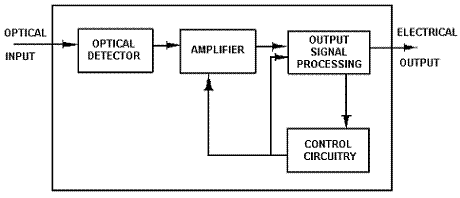Optical Detectors
INTRODUCTION TO OPTICAL DETECTORS AND FIBER OPTIC RECEIVERS
The last section taught you that a fiber optic transmitter is an electro-optic device capable of accepting electrical signals, converting them into optical signals, and launching the optical signals into an optical fiber. The optical signals propagating in the fiber become weakened and distorted because of scattering,absorption, and dispersion. The fiber optic device responsible for converting the weakened and distorted optical signal back to an electrical signal is a fiber optic receiver.
A fiber optic receiver is an electro-optic device that accepts optical signals from an optical fiber and converts them into electrical signals. A typical fiber optic receiver consists of an optical detector, a low-noise amplifier, and other circuitry used to produce the output electrical signal (see the picture below).

Block diagram of a typical fiber optic receiver.
The optical-detector converts the incoming optical signal into an electrical signal. The amplifier then amplifies the electrical signal to a level suitable for further signal processing. The type of other circuitry contained within the receiver depends on what type of modulation is used and the receiver electrical output requirements.
Receiver spectral response, sensitivity, frequency response, and dynamic range are key receiver performance parameters that can affect overall system operation. The choice of optical-detector materials and structures determines the spectral response. Silicon (Si), gallium arsenide (GaAs), and gallium aluminum arsenide (GaAlAs) are typical detector materials used for receiver operation in the 850-nm wavelength region. germanium (Ge), indium phosphide (InP), and indium gallium arsenide (InGaAs) are examples of detector materials used for receiver operation in the 1300-nm and 1550-nm wavelength regions.
The receiver sensitivity is the minimum amount of optical power required to achieve a specific receiver performance. For digital transmission at a given data rate and coding, this performance isdescribed by a maximum bit-error rate (BER). In analog systems, for a given modulation and bandwidth, it is described by a minimum signal-to-noise ratio (SNR). Dynamic range refers to the range of optical power levels over which the receiver operates within the specified values. It usually is described by theratio of the maximum input power to the sensitivity. Before discussing receiver sensitivity, bandwidth, dynamic range, and frequency response in more detail, we discuss the main types of optical-detectors used in fiber optics.
OPTICAL DETECTORS
A transducer is a device that converts input energy of one form into output energy of another. An optical-detector is a transducer that converts an optical signal into an electrical signal. It does this by generating an electrical current proportional to the intensity of incident optical radiation. The relationship between the input optical radiation and the output electrical current is given by the detector responsivity.Responsivity is discussed later in this section.
OPTICAL DETECTOR PROPERTIES
Fiber optic communications systems require that optical- detectors meet specific performance and compatibility requirements. Many of the requirements are similar to those of an optical source. Fiber optic systems require that optical detectors:
· Be compatible in size to low-loss optical fibers to allow for efficient coupling and easy packaging.
· Have a high sensitivity at the operating wavelength of the optical source.
· Have a sufficiently short response time (sufficiently wide bandwidth) to handle the system's data rate.
· Contribute low amounts of noise to the system.
· Maintain stable operation in changing environmental conditions, such as temperature.
Optical-detectors
that meet many of these requirements and are suitable for fiber optic
systems are semiconductor photodiodes. The principal optical detectors
used in fiber optic systems include semiconductor
positive-intrinsic-negative (PIN) photodiodes and avalanche photodiodes
(APDs).
Semiconductor Photodiodes
Pin Photodiodes
Avalanche Photodiodes
Fiber Optic Receivers
Receiver Design















